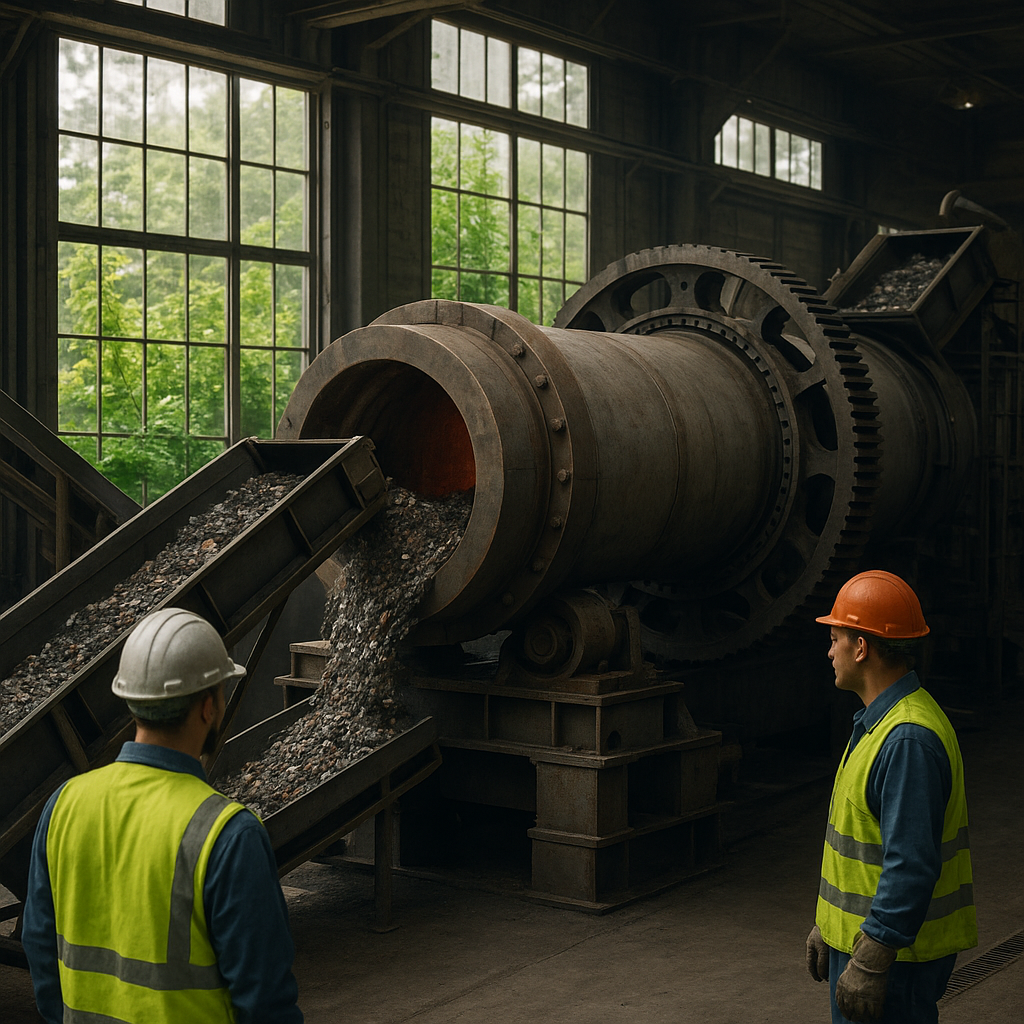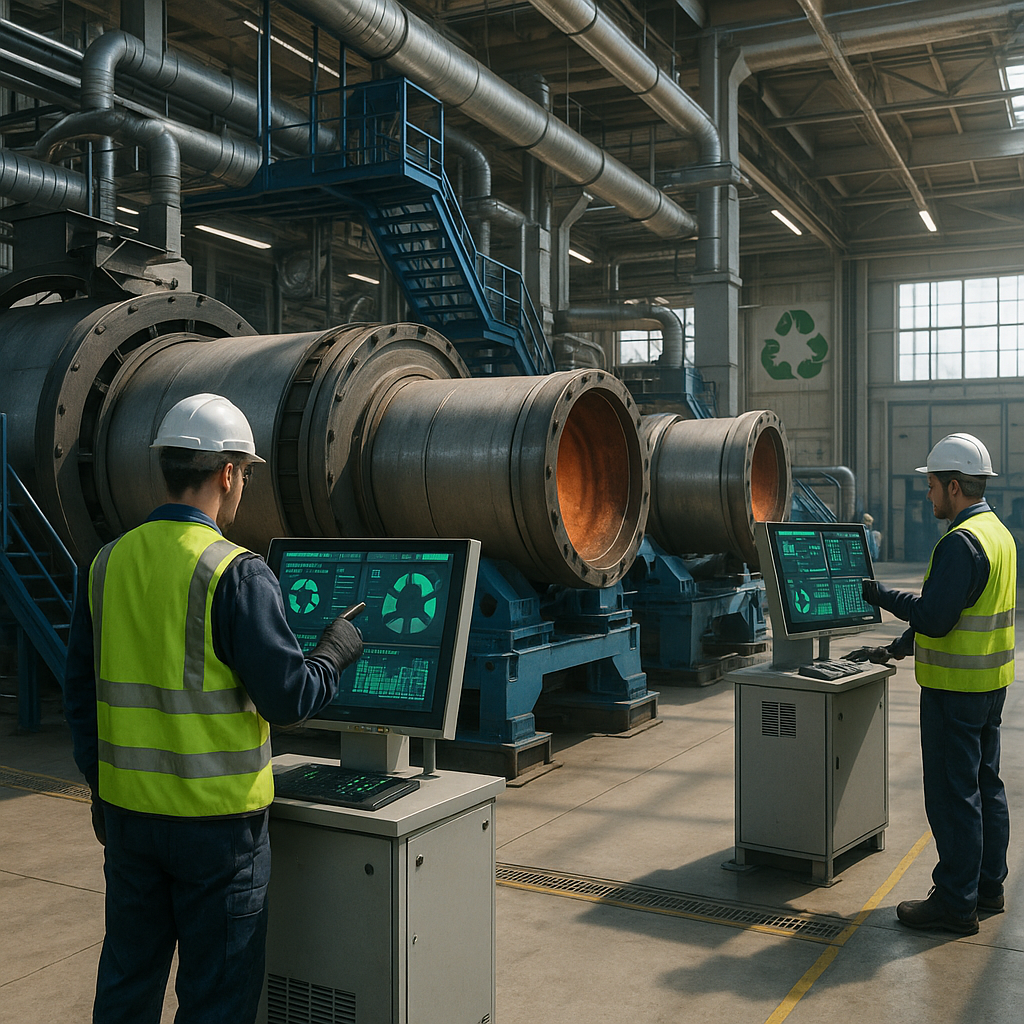5901 Botham Jean Blvd, Dallas, TX 75215
What is a Rotary Kiln and How Does it Work in Metal Recycling?
October 14, 2025Rotary kilns have become essential equipment in modern metal recycling operations due to their unique design and operational capabilities, offering significant advantages over alternative technologies. They are particularly effective for processing complex waste streams containing valuable metals.
How Are Rotary Kilns Optimized for Different Metal Recycling Applications?
Rotary kilns serve as versatile workhorses in metal recycling operations, with their effectiveness depending on proper customization for specific recovery processes. These industrial furnaces can be tailored to handle various metal-bearing waste streams, from e-waste to industrial byproducts, through careful engineering and parameter optimization.
The choice between direct-fired and indirect-fired kilns is a critical customization decision. In direct-fired kilns, combustion gases directly contact the material, offering greater thermal efficiency and cost-effectiveness. However, this design can result in some metal loss as volatile components may exit with exhaust gases.
Indirect-fired kilns (also called calciners) keep combustion gases separate from the processed materials by heating the kiln shell externally. While they are less thermally efficient, this design significantly reduces metal losses to the stack and generates valuable syngas, which can be captured and reused for other heating applications within the facility.
Key Parameter Optimization
Beyond the basic configuration, several operational parameters must be fine-tuned for maximum metal recovery and energy efficiency:
- Retention time: The duration materials remain in the kiln directly impacts recovery rates. For complex metal-bearing materials like circuit boards, longer retention times ensure complete volatilization of plastics and proper liberation of precious metals.
- Temperature profiles: Precise temperature control throughout different kiln zones allows for targeting specific metal recovery processes. For instance, lower temperatures in early zones can drive off moisture, while higher temperatures in later zones facilitate metal separation.
- Rotational speed: This controls material movement through the kiln and affects heat transfer rates. Slower rotation provides more contact time but may reduce throughput capacity.
- Internal atmosphere: The gas composition inside the kiln can be adjusted between oxidizing or reducing conditions depending on the target metals and desired reactions.
Testing is essential for optimizing these parameters. Leading manufacturers conduct batch or pilot tests to determine the precise settings needed for specific feed materials before scaling to production systems.
Advanced Engineering Features
Modern rotary kilns for metal recycling incorporate sophisticated design elements that enhance performance and environmental compliance:
- Gas-tight sealing systems: Prevent unwanted air infiltration that can disrupt controlled atmospheres and reduce efficiency.
- Specialized materials of construction: High-temperature alloys and refractory linings resist corrosion from metal-bearing materials.
- Integrated pollution control: Systems for capturing and treating emissions ensure compliance with environmental regulations.
- Heat recovery mechanisms: Capture waste heat from exhaust gases to improve overall energy efficiency.
The effectiveness of these features is evident in applications like lithium-ion battery recycling, where rotary kilns with specialized temperature control systems and gas handling equipment can recover valuable metals while safely managing potentially hazardous components. The right kiln design can increase recovery rates of critical materials like lithium, cobalt, and nickel by over 90% compared to conventional processes.
Collaborating with experienced rotary kiln manufacturers provides access to proven designs and process expertise. These partnerships ensure that metal recyclers implement optimized, energy-efficient systems matched precisely to their input materials and recovery goals, maximizing the value of recovered metals while minimizing operational costs and environmental impact.
| Parameter | Direct-Fired Kiln | Indirect-Fired Kiln |
|---|---|---|
| Heat Transfer | Direct contact with combustion gases | Indirect via the kiln shell |
| Applications | Materials tolerant to combustion gases | Materials sensitive to contaminants |
| Temperature Control | Less precise | More precise |
| Efficiency | Higher due to direct heat transfer | Lower due to indirect heat transfer |
| Cost | More cost-effective | Higher due to additional components |
| Metal Loss | Potential for metal loss with exhaust gases | Reduced metal loss, generates syn-gas |
What Role Do Rotary Kilns Play in the Circular Economy and Sustainability?

Rotary kilns play a crucial role in advancing circular economy principles by converting waste streams into valuable resources. These industrial machines operate at high temperatures, creating an ideal environment for recovering metals from waste materials that might otherwise end up in landfills.
The recovery process significantly reduces the need for virgin mining. Recovering metals from waste, rather than extracting them from the earth, considerably lowers the carbon footprint of metal production. This decrease in environmental impact is vital as industries strive for more sustainable practices worldwide.
Rotary kilns excel in processing various waste materials, ranging from electronic waste containing precious metals to industrial byproducts like fly ash from power plants and slag from steel manufacturing. This versatility makes them indispensable in modern recycling operations.
Metal Recovery and Resource Conservation
The technology behind rotary kilns enables the extraction of valuable metals such as aluminum, copper, gold, and rare earth elements from waste streams. This process is particularly important given the supply constraints and rising demand for these metals due to technological advancement.
By recovering metals that would otherwise be lost, rotary kilns directly contribute to conserving finite resources and reducing landfill waste, addressing two major environmental challenges simultaneously.
For example, processing electronic waste through rotary kilns can recover up to 95% of the precious metals in circuit boards, providing substantial environmental and economic benefits.
Urban Mining: A Sustainable Alternative
Rotary kilns support the growing practice of urban mining—the systematic recovery of materials from urban waste streams. This approach views waste not as a problem to be disposed of but as a resource to be harvested.
Urban mining through rotary kiln technology helps create a more circular material flow within the economy. Materials are kept in use for longer periods through recovery and reprocessing, rather than being discarded after a single use.
The environmental benefits are substantial. For every ton of copper recovered through urban mining rather than traditional mining, approximately 100 tons of mining waste are avoided. Similar benefits apply to other metals and materials.
Energy Recovery and Waste Reduction
Besides metal recovery, rotary kilns enable energy recovery from waste. Some systems are designed to convert waste into energy through pyrolysis or gasification, transforming organic waste into syngas, biochar, or bio-oil—valuable fuel sources.
The dual capability of material and energy recovery positions rotary kilns as essential technologies in waste reduction strategies. They help decrease waste volume while generating energy, offering a win-win solution for waste management challenges.
Additionally, rotary kilns can process hazardous waste, converting dangerous materials into inert substances while recovering valuable components. This capability is crucial for safely managing complex waste streams while maximizing resource recovery.
Future Potential in Sustainability
The role of rotary kilns in circular economy applications continues to grow. Recent innovations focus on enhancing energy efficiency and emission controls, making these systems even more environmentally friendly.
Advanced automation and control systems now allow for more precise operation, optimizing both resource recovery rates and energy use. These improvements further enhance the sustainability credentials of rotary kiln technology.
As industries face increasing pressure to reduce environmental impacts and maximize resource efficiency, rotary kilns are likely to play an even more prominent role in circular economy strategies in the coming years.
By enabling the recovery of valuable materials from waste, reducing the need for virgin resource extraction, and minimizing landfill waste, rotary kilns represent a critical technology in transitioning toward a more sustainable and circular economy.
Conclusion: The Future of Rotary Kilns in Metal Recycling

Rotary kilns are at the forefront of sustainable metal recycling solutions. Their unmatched versatility allows them to process diverse waste streams while maintaining high efficiency standards. As global resource scarcity concerns grow, these robust systems will become essential for recovering valuable metals from electronic waste, industrial byproducts, and other complex materials.
Technological advancements continue to enhance rotary kiln performance. Innovations such as automated monitoring, advanced emission controls, and energy-efficient designs are making these systems more environmentally friendly and cost-effective. These improvements position rotary kilns as critical components in the circular economy, helping businesses meet stringent environmental standards while maintaining competitive advantages. For organizations looking to boost their metal recycling capabilities, contact Okon Recycling at 214-717-4083.
